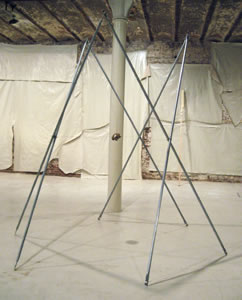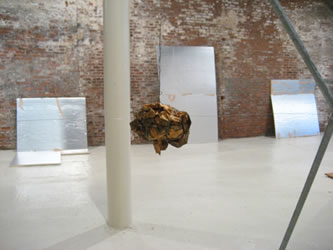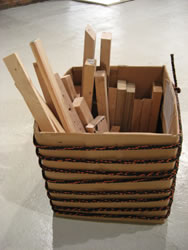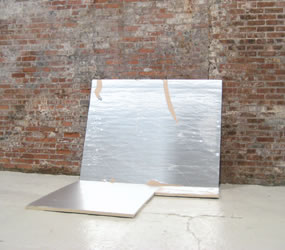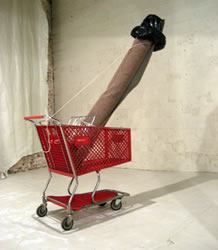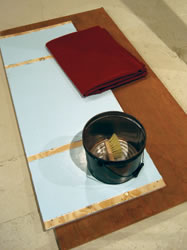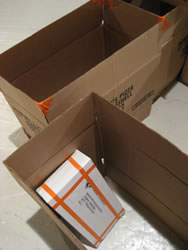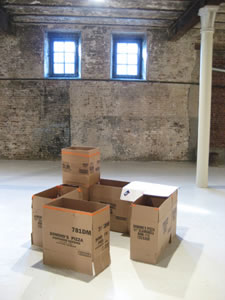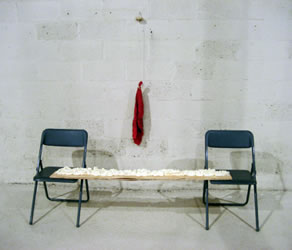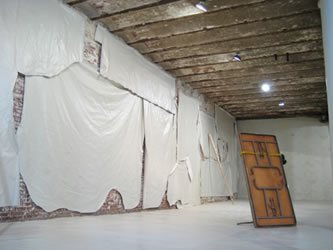
Press Coverage
Johnson, Paddy. "Notes on Triple Candie." artfagcity.com. Posted January 17, 2007.
Winkleman, Edward. "If a Sculpture Falls in an Empty Gallery, and Nobody Hears It . . .Edwinkleman.blogspot.com. Posted January 16, 2007.
Main Space
Lester Hayes: Selected Work, 1962 - 1975 (December 3, 2006 - January 21, 2007)
Biography
1936 Born in Philadelphia, the second of three children, to Robert Hayes, an African American originally from South Carolina who works as a librarian at the University of Pennsylvania, and Nicoletta Diacono, an Italian American who works as a seamstress.
1942-51 Attends elementary and middle school; excels in sciences and math. Sees first art exhibition at the Philadelphia Art Museum.
1948 Parents separate; father leaves family and moves to Greensboro, North Carolina; Hayes moves with mother and two siblings to North Philadelphia.
1951-54 Attends Northeast High School; serves as captain of the school’s track team; wins State Science Award; draws cartoons for school newspaper.
1954-57 Gains entry into Pennsylvania State University on a track scholarship; seriously injures leg in sophomore year and is forced to stop running; studies chemical engineering and graduates in three years; begins making collage paintings and sculptural assemblages.
1958 Moves to Scranton, Pennsylvania. Works as a science teacher at West Scranton High School.
1961 Reads Robert Motherwell’s The Dada Painters and Poets: An Anthology (1951). Decides to dedicate himself more fully to his art. In a letter to his mother, he writes, “Science has provided me a way to relate to the world in abstract terms, but art, increasingly, leads me down a path that is both tangible and self-reflexive.”
1962 Moves to New York City and lives in Greenwich Village; secures job teaching science at Wadleigh High School in Harlem. Visits galleries and meets artists through the abstract painter Herbert Gentry.
1965 Secures part-time job as Richard Tuttle’s first studio assistant, working in his studio for a period of eight months. Befriends several artists who show with Leo Castelli Gallery. Castelli himself visits studio at end of year. Talks to him about showing in a group exhibition at his gallery.
1966 Accepted to participate in 1967 Whitney Annual (now the Biennial). Moves to larger apartment in Washington Heights; uses living room as studio and sleeps in hallway on a cot. Starts making large, monochromatic paintings on unstretched canvas, which he nails directly to wall. Declines invitation to join Spiral Group.
1967 Quits job at Wadleigh School to prepare for first solo exhibition in New York at Richard Feigen Gallery. In a letter to the collector Robert Scull, Feigen notes that Hayes’ work “combines an intellectual rigor with a lyrical off-hand improvisation.” Scull considers purchasing a large, unstretched wall-work, but decides to acquire a small drawing (now lost).
1968 Wins fellowship from National Endowment for the Arts. Feigen Gallery exhibition opens to great anticipation but none of the major works sell. Financially destitute, Hayes starts bartending at Max’s Kansas City.
1969 Sees “Harlem on My Mind” exhibition at Metropolitan Museum of Art; Tom Lloyd and Benny Andrews invite him to join them in protesting the exhibition but he declines. Writes letter to the editor of Arts magazine in support of the exhibition, noting that “it is ultimately more important for our community as a whole to be better understood, then for specific individuals to be celebrated via their art work.” Participates in Art Expo ‘69 at the New York Convention Center.
1970 Invited to participate in “Contemporary African American Art” exhibition at the Whitney Museum (scheduled for 1972); declines. Begins teaching as a part-time lecturer in fine art at Pratt Institute, Brooklyn.
1971 Richard Feigen cancels next solo exhibition, citing lack of interest in Hayes’ work. Through Barry LeVa meets Sharon Singer, a painter twelve years his junior. Together they move to Bedford Steyvesant, Brooklyn. Continues teaching at Pratt.
1972 Father dies in a car accident. Invited to be Visiting Artist at Kansas City Art Institute.
1973 Exhibits in three-person show at 98 Greene Street, New York.
1975 Solo exhibition at Just Above Midtown Gallery, New York.
1976 Offered non-tenure track position at Carnegie Mellon University, which he accepts, planning to stay only three or four years. Moves with Singer to Pittsburgh; ends up staying until 1984.
1978 Has solo exhibition at the Kresge Art Museum, Michigan State University, Lansing, Michigan.
1980 Exhibits in two-person exhibition at Philadelphia Art Alliance.
1984 Resigns from Carnegie Mellon University, writing in a letter to Dean of the Faculty that he is disappointed by a growing number of administrative commitments that are keeping him out of the studio.
1985 Purchases small house with large open room that he converts to a studio, just outside the city.
1986 House catches fire and burns to the ground, destroying nearly all of his artwork. Distraught, decides to abandon artmaking. Begins teaching at a local community college.
1992 Moves into apartment in downtown Greensboro and falls into a deep depression; works part-time as a science tutor.
1999 Sister dies of congestive heart failure.
2004 Dies of complications from diabetes on December 12th.
Exhibition Note: Lester Hayes is a fictional creation of Triple Candie. Because his works were lost in a fire, the objects in this exhibition were all recreated by Triple Candie with the permission of the artist's estate.

